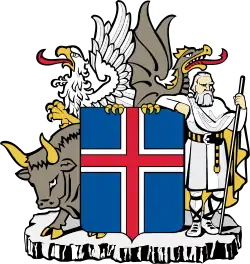| |||||||||||||||||||||
6 of the 14 seats in the Upper House of Althing | |||||||||||||||||||||
| Turnout | 24.28% | ||||||||||||||||||||
|---|---|---|---|---|---|---|---|---|---|---|---|---|---|---|---|---|---|---|---|---|---|
This lists parties that won seats. See the complete results below.
| |||||||||||||||||||||
 |
|---|
|
|
Parliamentary elections were held in Iceland on 5 August 1916,[1] the first elections held after women's suffrage was introduced.[2] Following reforms to the Althing the previous year, the six seats in the Upper House appointed by the monarch were abolished, and replaced with six elected seats.[2] The seats were elected by proportional representation at the national level, using the D'Hondt method.[2] The remaining eight seats were elected along with the Lower House in October.
Results
| Party | Votes | % | Seats | |
|---|---|---|---|---|
| Home Rule Party | 1,950 | 33.45 | 3 | |
| Independence Party – Þversum | 1,337 | 22.94 | 2 | |
| Independent Farmers | 1,290 | 22.13 | 1 | |
| Farmers' Party | 435 | 7.46 | 0 | |
| Independence Party – Langsum | 419 | 7.19 | 0 | |
| Social Democratic Party | 398 | 6.83 | 0 | |
| Total | 5,829 | 100.00 | 6 | |
| Valid votes | 5,829 | 99.25 | ||
| Invalid/blank votes | 44 | 0.75 | ||
| Total votes | 5,873 | 100.00 | ||
| Registered voters/turnout | 24,189 | 24.28 | ||
| Source: Mackie & Rose,[3] Nohlen & Stöver | ||||
References
This article is issued from Wikipedia. The text is licensed under Creative Commons - Attribution - Sharealike. Additional terms may apply for the media files.